In Sickness and In Health
Wednesday, November 23, 2005
I've been sick and busy and distracted recently, and that combined with not doing much that is terribly noteworthy has led to a slowdown in picture taking, and thus a slowdown in blogging. I present to you the random things I've been doing:
First a couple stories. At the beginning of last week, the principal of Osaki Junior High invited me into his office to show me the spot he had put my drawing. It was very nice, and so I thanked him and we said nice things and I thought that would be that. As I was leaving though, he asked me if I could sign it. Actually, said I, I did already sign it, right over here. Ah, says he, but it is so small. Could you sign it bigger? He gave me a pencil, and I erased my small hard-to-see signature and put in a larger, quite obvious signature. There, says I, enjoy. Actually, it's not big enough, says he. Could you do it again? Here is an eraser. Again, I erase, and sign, this time the signature is huge, if it were printed maybe 16 point type. Ah, says he, very nice. A big smile, and he puts it back on the shelf. So it goes.
That same day, Miyamoto Sensei, the young English teacher I sit next to at Osaki told me that her favorite TV program had been on last night, and she told me about the story. It's a tragedy, a young girl is terminally ill, and in love, and a broken family or something. Either way, when I asked her what it was called, she told me the Japanese name, in which I only understood "One Liter" and then I missed the rest. I asked her what the title meant and she told me the name of the show is "One Liter of Tears." These Japanese TV producers - they don't mess around with their titles. You know what you're getting into. The show on after One Liter of Tears is a comedy, says she. It's called "Devil Wife."
I've been scootering, and I've found a drive that in about 45 minutes gives you a sampling of everything that this island has to offer. I did it on a cold day in failing light, so I didn't take pictures of everything the island has to offer, but I took a couple pictures. Sunsets, so sue me.
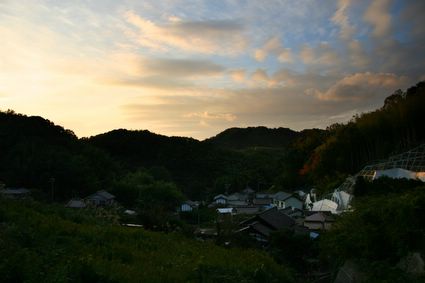
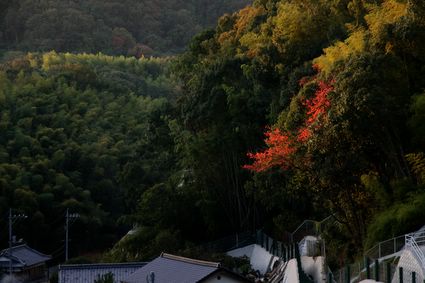


Next subject. Culture festivals and special-education in Japan. Last Sunday was the Nishino Elementary culture festival. These festivals are a half-day of songs, plays, and music, sort of like the elementary school plays and music back home, but all together in one day, with each class taking a turn. They are long and you watch them sitting on the floor of a cold cold gym, huddling up to a kerosene heater. But that's beside the point.
The festivals themselves are pretty funny, the plays are either folktales or stories about farming, and the music is played with the most random instruments (one piece was a snare drum, recorders, accordions, xylophones, cymbals, electric organs, and triangle). The setting is always the mustard yellow or pale green gym stage curtain, and the kids are forever forgetting their lines.

A first and second grade play about farms. Behind lightning and thunder here, you can see the vegetables. That's two potatoes on the left, and a Daikon on the right. (A Daikon is a big Japanese radish.)

The third and fourth grader's play (in English!).

The ever-present kerosene heaters. Thank goodness for these things.

Some musical instrument. What is it called? I have no idea. Respirator tube accordion? The breathboard? The blower piano? Who knows.
Which leads me to the next part. In Japan, there is no such thing as special ed. Kids with learning disabilities, from mild to severe, are simply put through school with everyone else. They take the same classes, they participate in all events, they have the same schedules, and they pretty much are treated like any other student. At some of my schools, I have a ninth grade girl who is severely autistic, she doesn't speak, has a woman who sits next to her in all her classes, and just draws vertical lines on any paper put in front of her. In a fifth grade class there's a girl who can seem normal and calm, smiling and laughing and trying to sound out English words until she jumps out of her chair, jumps up and down, and tries to hit her head on her desk. There's a seventh grader who sits at the front of the class, can write his name in Kanji, but then writes nothing else and stares out the window, making soft melodic sounds and smiling the most charming smiles. At Nishino, where this culture festival was, there is Nobu-kun, a fifth grader who can understand some Japanese, can say "hello," but can't do much else on his own. Like many of the other schools, Nishino provides a teacher to sit with him, play with him, help him eat, and take care of him all day every day. I wonder, when I see these situations if the Japanese system is inspired or just wrong.
There are enough kids with serious disabilities to fill one medium sized special ed class on the island. Would it be better that way? I don't know. The disabled kids at school are definitely used to being around large groups of normal kids, and have learned what they can and can't do (in most cases). More interestingly, the kids without disabilities don't seem to even notice the kids with problems. If they are on stage, and need to file of in order, someone behind a disabled kid will just grab his shoulders and steer him in the right direction. If the girl who hits her head on the desk starts getting worked up, the girl sitting next to her holds her hand and calms her down without batting an eyelash. If the seventh grader who sings to himself gets loud during glass, someone sitting next to him quietly shushes him and the class goes on.
That part of things is definitely good, and it certainly is nice to see a culture where mentally disabled people aren't hidden away, but I have to wonder what they are getting out of sitting through week after week of math classes, history classes, English classes, and all the other classes that everyone goes to. Could they be learning more, doing better, making progress if they were in a special school, or a special class? I don't know, but sometimes I wonder.
I took some pictures of Nobu-kun at his culture festival.
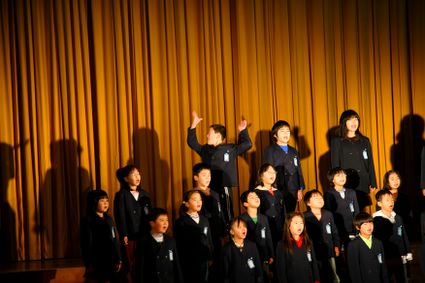
The students sing while Nobu checks out the shadows.
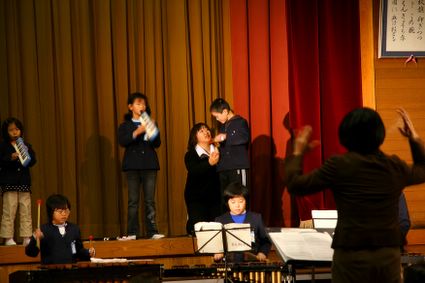
With his caretaker, playing percussion.
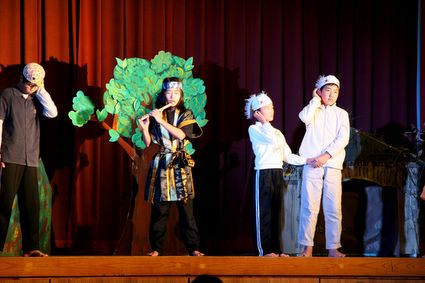
In the play with Naoto-kun, a sixth grader.

Anyway.
On Monday I got a day off for going to the culture festival on Sunday, so I went to Hiroshima to do some immigration stuff. Mori was visiting his 28 year old girlfriend, so he gave me a ride home.

I lent him my sunglasses when it got sunny.

One of the about 50 tunnels you go through between Takehara and Hiroshima.
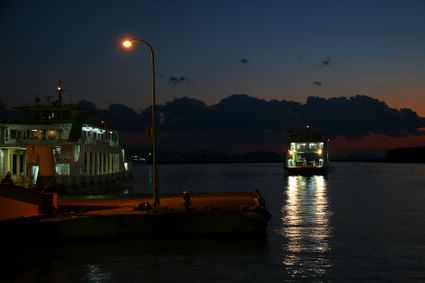
The evening ferry from Takehara.
Today Mori, Mori's friend, and I went fishing. We took a small boat (how many boats does Mori have? I don't know.) and went to a floating wooden platform, and we fished for small fish.

Mori's friend. Name forgotten.

On the platform. We mixed seawater, sand, rice flour, fish powder, and shrimp into a sandy mush, and then threw balls of it into the water all around us. The fish in the water became a thick school, and we didn’t even need bait for the first hour. The line had a rig of six hooks on it, and it wasn't uncommon to pull three or four fish out as soon as you dropped your line in. In about two hours we caught about 30 fish. The biggest one was maybe 8 inches long.
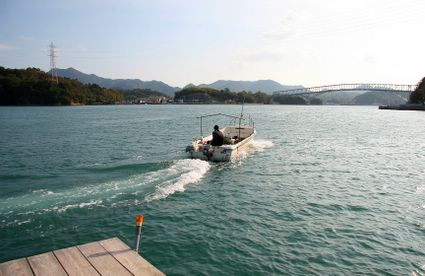
Mori had to go back and get more fish powder, so we were left on the raft for half an hour. My Japanese must be improving, as I was able to make some rough small talk. Yes!
First a couple stories. At the beginning of last week, the principal of Osaki Junior High invited me into his office to show me the spot he had put my drawing. It was very nice, and so I thanked him and we said nice things and I thought that would be that. As I was leaving though, he asked me if I could sign it. Actually, said I, I did already sign it, right over here. Ah, says he, but it is so small. Could you sign it bigger? He gave me a pencil, and I erased my small hard-to-see signature and put in a larger, quite obvious signature. There, says I, enjoy. Actually, it's not big enough, says he. Could you do it again? Here is an eraser. Again, I erase, and sign, this time the signature is huge, if it were printed maybe 16 point type. Ah, says he, very nice. A big smile, and he puts it back on the shelf. So it goes.
That same day, Miyamoto Sensei, the young English teacher I sit next to at Osaki told me that her favorite TV program had been on last night, and she told me about the story. It's a tragedy, a young girl is terminally ill, and in love, and a broken family or something. Either way, when I asked her what it was called, she told me the Japanese name, in which I only understood "One Liter" and then I missed the rest. I asked her what the title meant and she told me the name of the show is "One Liter of Tears." These Japanese TV producers - they don't mess around with their titles. You know what you're getting into. The show on after One Liter of Tears is a comedy, says she. It's called "Devil Wife."
I've been scootering, and I've found a drive that in about 45 minutes gives you a sampling of everything that this island has to offer. I did it on a cold day in failing light, so I didn't take pictures of everything the island has to offer, but I took a couple pictures. Sunsets, so sue me.




Next subject. Culture festivals and special-education in Japan. Last Sunday was the Nishino Elementary culture festival. These festivals are a half-day of songs, plays, and music, sort of like the elementary school plays and music back home, but all together in one day, with each class taking a turn. They are long and you watch them sitting on the floor of a cold cold gym, huddling up to a kerosene heater. But that's beside the point.
The festivals themselves are pretty funny, the plays are either folktales or stories about farming, and the music is played with the most random instruments (one piece was a snare drum, recorders, accordions, xylophones, cymbals, electric organs, and triangle). The setting is always the mustard yellow or pale green gym stage curtain, and the kids are forever forgetting their lines.

A first and second grade play about farms. Behind lightning and thunder here, you can see the vegetables. That's two potatoes on the left, and a Daikon on the right. (A Daikon is a big Japanese radish.)

The third and fourth grader's play (in English!).

The ever-present kerosene heaters. Thank goodness for these things.

Some musical instrument. What is it called? I have no idea. Respirator tube accordion? The breathboard? The blower piano? Who knows.
Which leads me to the next part. In Japan, there is no such thing as special ed. Kids with learning disabilities, from mild to severe, are simply put through school with everyone else. They take the same classes, they participate in all events, they have the same schedules, and they pretty much are treated like any other student. At some of my schools, I have a ninth grade girl who is severely autistic, she doesn't speak, has a woman who sits next to her in all her classes, and just draws vertical lines on any paper put in front of her. In a fifth grade class there's a girl who can seem normal and calm, smiling and laughing and trying to sound out English words until she jumps out of her chair, jumps up and down, and tries to hit her head on her desk. There's a seventh grader who sits at the front of the class, can write his name in Kanji, but then writes nothing else and stares out the window, making soft melodic sounds and smiling the most charming smiles. At Nishino, where this culture festival was, there is Nobu-kun, a fifth grader who can understand some Japanese, can say "hello," but can't do much else on his own. Like many of the other schools, Nishino provides a teacher to sit with him, play with him, help him eat, and take care of him all day every day. I wonder, when I see these situations if the Japanese system is inspired or just wrong.
There are enough kids with serious disabilities to fill one medium sized special ed class on the island. Would it be better that way? I don't know. The disabled kids at school are definitely used to being around large groups of normal kids, and have learned what they can and can't do (in most cases). More interestingly, the kids without disabilities don't seem to even notice the kids with problems. If they are on stage, and need to file of in order, someone behind a disabled kid will just grab his shoulders and steer him in the right direction. If the girl who hits her head on the desk starts getting worked up, the girl sitting next to her holds her hand and calms her down without batting an eyelash. If the seventh grader who sings to himself gets loud during glass, someone sitting next to him quietly shushes him and the class goes on.
That part of things is definitely good, and it certainly is nice to see a culture where mentally disabled people aren't hidden away, but I have to wonder what they are getting out of sitting through week after week of math classes, history classes, English classes, and all the other classes that everyone goes to. Could they be learning more, doing better, making progress if they were in a special school, or a special class? I don't know, but sometimes I wonder.
I took some pictures of Nobu-kun at his culture festival.

The students sing while Nobu checks out the shadows.

With his caretaker, playing percussion.

In the play with Naoto-kun, a sixth grader.

Anyway.
On Monday I got a day off for going to the culture festival on Sunday, so I went to Hiroshima to do some immigration stuff. Mori was visiting his 28 year old girlfriend, so he gave me a ride home.

I lent him my sunglasses when it got sunny.

One of the about 50 tunnels you go through between Takehara and Hiroshima.

The evening ferry from Takehara.
Today Mori, Mori's friend, and I went fishing. We took a small boat (how many boats does Mori have? I don't know.) and went to a floating wooden platform, and we fished for small fish.

Mori's friend. Name forgotten.

On the platform. We mixed seawater, sand, rice flour, fish powder, and shrimp into a sandy mush, and then threw balls of it into the water all around us. The fish in the water became a thick school, and we didn’t even need bait for the first hour. The line had a rig of six hooks on it, and it wasn't uncommon to pull three or four fish out as soon as you dropped your line in. In about two hours we caught about 30 fish. The biggest one was maybe 8 inches long.

Mori had to go back and get more fish powder, so we were left on the raft for half an hour. My Japanese must be improving, as I was able to make some rough small talk. Yes!